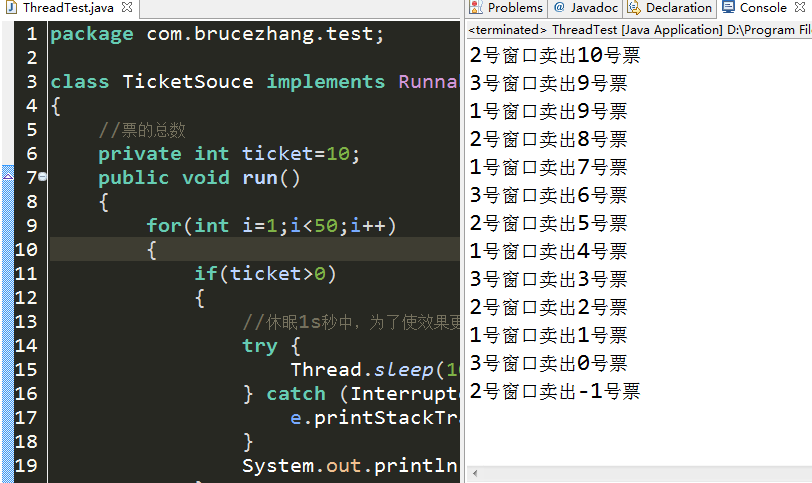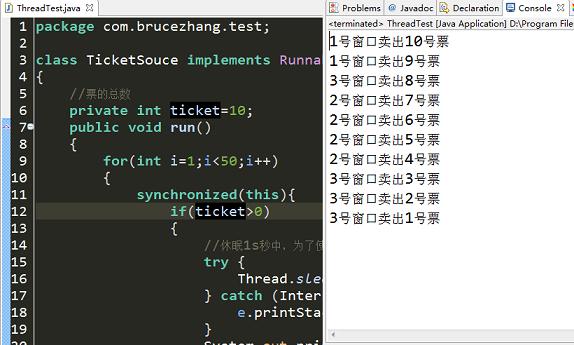先來看一個不帶線程同步的例子,這個例子很簡單,只是讓兩個線程輸出同樣的內容,並不做其他的事, 所以,線程同步在這裡體現的並不明顯。
import java.util.Date;
public class ThreadTest extends Thread{
int pauseTime;
String name;
/**
* @param args
*/
public static void main(String[] args) {
// TODO Auto-generated method stub
ThreadTest tT1 = new ThreadTest(1000, "Thread1");
tT1.start();
ThreadTest tT2 = new ThreadTest(3000, "Thread2");
tT2.start();
}
public ThreadTest(int pauseTime , String name){
this.pauseTime = pauseTime;
this.name = name;
}
@Override
public void run() {
// TODO Auto-generated method stub
super.run();
while(true){
try {
System.out.println(name + ":"
+ new Date(System.currentTimeMillis()));
Thread.sleep(pauseTime);
} catch (Exception e) {
// TODO: handle exception
e.printStackTrace();
}
}
}
}
在來看一個多線程售票的問題,這個例子中體現線程同步的重要性 ,不保證這一點將會導致錯誤的執行結果
class TicketSouce implements Runnable
{
//票的總數
private int ticket=10;
public void run()
{
for(int i=1;i<50;i++)
{
if(ticket>0)
{
//休眠1s秒中,為了使效果更明顯,否則可能出不了效果
try {
Thread.sleep(1000);
} catch (InterruptedException e) {
e.printStackTrace();
}
System.out.println(Thread.currentThread().getName()+"號窗口賣出"+this.ticket--+"
號票");
}
}
}
}
public class Test {
public static void main(String args[])
{
TicketSouce mt=new TicketSouce();
//基於火車票創建三個窗口
new Thread(mt,"1").start();
new Thread(mt,"2").start();
new Thread(mt,"3").start();
}
}
輸出結果如下圖所示:

可以看到,輸出的結果並不是我們想要的,所以,需要線程同步的支持
當一個線程要使用火車票 這個資源時,我們就交給它一把鎖,等它把事情做完後在把鎖給另一個要用這個資源的線程。這樣就不會出現 上述情況。 實現這個鎖的功能就需要用到synchronized這個關鍵字。
synchronized這個關鍵字有兩種 用法1、放方法名前形成同步方法;2、放在塊前構成同步塊。
我們首先用第一種方法實現售票的功能 :
代碼如下:
class TicketSouce
implements Runnable
{
//票的總數
private int ticket=10;
public void run()
{
for(int i=1;i<50;i++)
{
try {
//休眠1s秒中,為了使效果更明顯,否則可能出不了效果
Thread.sleep(1000);
} catch (InterruptedException e) {
e.printStackTrace();
}
this.sale();
}
}
public synchronized void sale()
{
if(ticket>0)
{
System.out.println(Thread.currentThread().getName()+"號窗口賣出"+this.ticket--+"
號票");
}
}
}
public class Test {
public static void main(String args[])
{
TicketSouce mt=new TicketSouce();
//基於火車票創建三個窗口
new Thread(mt,"a").start();
new Thread(mt,"b").start();
new Thread(mt,"c").start();
}
}
第二種同步的方法如下:
class TicketSouce implements Runnable
{
//票的總數
private int ticket=10;
public void run()
{
for(int i=1;i<50;i++)
{
synchronized(this){
if(ticket>0)
{
//休眠1s秒中,為了使效果更明顯,否則可能出不了效果
try {
Thread.sleep(1000);
} catch (InterruptedException e) {
e.printStackTrace();
}
System.out.println(Thread.currentThread().getName()+
"號窗口賣出" + this.ticket-- + "號票");
}
}
}
}
}
public class ThreadTest {
//主線程
public static void main(String args[])
{
TicketSouce mt=new TicketSouce();
//建立三個線程,同步操作
new Thread(mt,"1").start();
new Thread(mt,"2").start();
new Thread(mt,"3").start();
}
}
兩段程序輸出的結果如下所示:

可以看到,兩段程序都有正確的輸出。
注意:同步關鍵字需要放對地方,否則可能出現不可預料的結果。